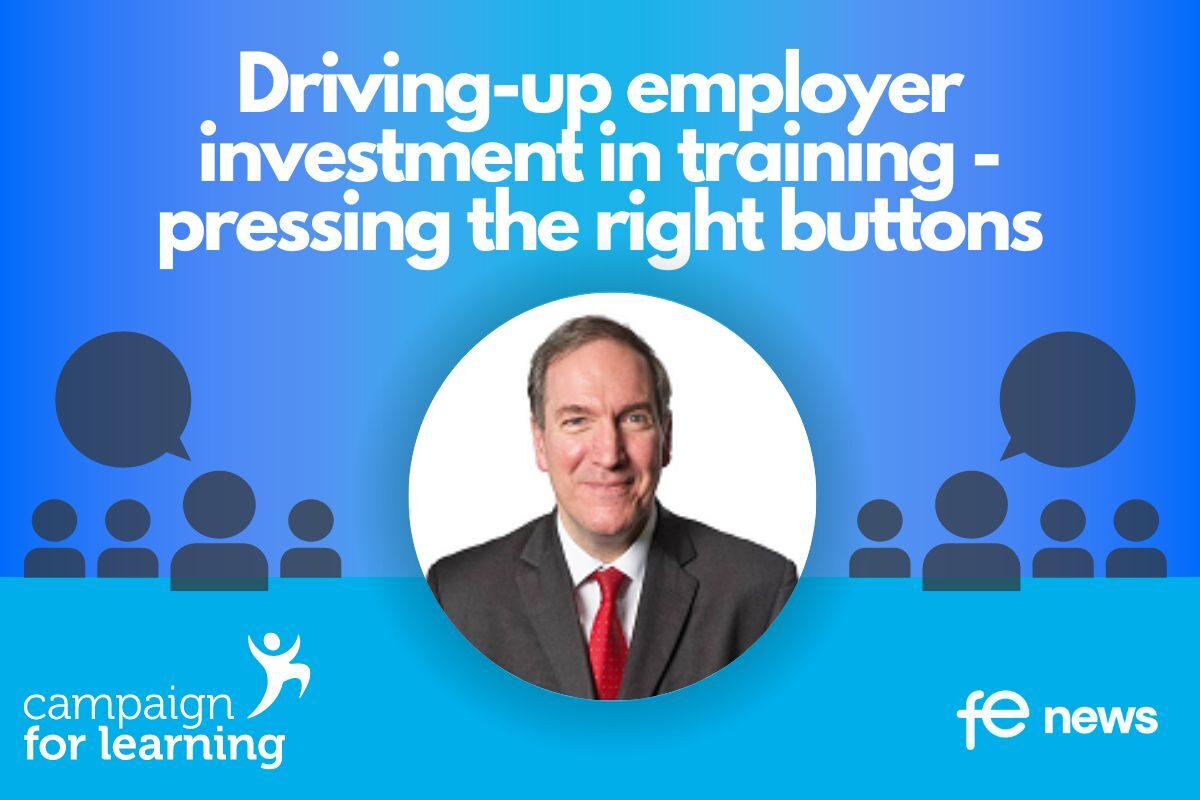Why should employers invest in training with large net worker migration into the UK?

On Thursday, 23rd June 2016, the UK voted to leave the European Union and some three and a half years later, on Friday, 31st January 2020, the UK formally left. The transition period ended on Thursday, 31st December 2020 and the free movement of people – including workers – between the UK and European Union member states ceased.
As a consequence, the UK was in a position to determine migration into the UK – especially of workers – from the rest-of-the-world (RoW) and the European Union (EU), and critically the scale of net migration. The points-based immigration system allows the UK to determine overall net migration between the RoW and EU. The UK can decide whether for a given level of net migration, more workers come from the RoW relative to the EU.
Scale of net migration and employer investment training
In many ways, however, the source of net migration of workers is a secondary order issue of employer investment in training policy. It is the scale that matters.
A tight worker immigration worker policy implies a greater focus on training the resident workforce including employers investing more in training. A loose worker immigration policy – irrespective of whether the source of labour is from the EU or the RoW – means employers can recruit skilled labour from the external labour market.
Changes to worker immigration policies
Prior to Brexit, one of the four pillars of our membership of the EU was freedom of movement of labour for EU citizens. Highly skilled workers from outside the European Economic Area and Switzerland, who had a qualifying job offer in the UK or a job on the Government’s Shortage Occupation List (SOL), could apply for a Tier 2 General Work visa. As a general rule, a Tier 2 Visa required a minimum salary offer of £30,000 per year. The result was that many EU workers tended to take lower skilled jobs with low rates of pay while non- Europeans obtained a visa for a higher paid post.
Brexit ended freedom of movement between Britain and Europe in January 2021 and both it and the Tier 2 system were replaced by the Skilled Worker visa for non-UK citizens wanting to come and work here. Specific eligibility depends on the job, but while the UK has ‘taken back control’ of its immigration policies, the new system is arguably more liberal than the previous regime.
Half of all jobs here are eligible for visas, yet employers still lobby for roles to be included on the Government’s Shortage Occupation List which affords more relaxed eligibility criteria for sponsored work visa applications. The agriculture and poultry sectors benefit separately from the Seasonal Worker visa scheme and international students have their own visa scheme.
The most high profile example of a new addition to the Shortage Occupation List has been care workers and home carers, where the minimum salary threshold is £20,480. Nevertheless, in making its recommendation for the addition, the Migration Advisory Committee (MAC) said that there should be a higher minimum wage for care workers. For other sectors, we should avoid a repeat of the Institute for Apprenticeships and Technical Education (IfATE) announcing in January 2023 a review of the hopelessly inadequate funding rate for adult care worker apprenticeships long after the profession was added to the SOL, and only after health and social care apprenticeship starts had slumped by 37%.
Before the new immigration rules were introduced, employers were undoubtedly using freedom of movement to fill both skilled and relatively unskilled vacancies, thus avoiding the need to invest in training or pay more. In the period 2014-19, the net growth of EU payrolled employees in the UK was 798,400 – an increase of 43.4% (UKICE working paper of January 2023 by Portes and Springford using ONS and HMRC data). As the Portes and Springford analysis shows, many of these workers were employed in sectors such as hospitality, care, logistics and retail.
A big challenge for policymakers who want to see less UK reliance on immigrant workers is that despite the regime change, net migration is now running at a record high of 504,000. While recognising the unprecedented spike in Hong Kong migrants, Ukrainian refugees and international students (most of whom return home after completing their course), a clear pattern has emerged. EU immigration has plunged to 43,000 – a fraction of the 230,000 to 430,000 EU citizens coming to the UK per year before 2020 – while the number of migrant workers from the rest of the world has increased significantly. From the employers’ perspective, the problem is compounded by the fact that many EU workers who returned home after being employed in low skilled sectors are not being replaced – hence the reports of restaurants and pubs having to reduce their opening hours.
A tighter or looser net worker immigration policy?
Nearly seven years later, the irony is that net migration to the UK is currently substantially higher than pre-pandemic levels.
We have record net migration – which goes against the Government’s intentions – at a time of record vacancies and major worries about the level of economic inactivity among older workers, while the number of 16-to-24 year olds who are NEET has shot up again to 788,000.
The Government and the CBI are bickering over who is to blame, with the former accusing the latter of “hankering for a broken model reliant on cheap labour from abroad and low wages for British workers”. The CBI, of course, recognises that despite employers’ frustrations, the Government will not want to make the visa regime even looser. And so, the CBI is instead calling for labour market interventions to be “the boldest in the world” to encourage more UK residents into employment.
A tight worker immigration policy and a step change in skills training
On the basis that the current Government is going to insist on a tight worker immigration policy, the Government will need to turbo-charge its skills strategy.
Employer Funded Training
The Government should seek to use the tax system to incentivise employers to invest their own resources in training. More thought needs to be given to a Super Skills Tax Deduction and a SME Skills Tax Credit outside of apprenticeships.
Apprenticeships
In the context of a tight worker immigration policy, the Apprenticeship Levy and digital account system in England is devolved at the right level – to each employer, as they know what their labour and skill needs are. Unless funding for non-levy paying SMEs is guaranteed, levy funding should remain restricted to apprenticeships only to continue to drive employer and societal support for apprenticeships.
Adult further education and skills
There remains a question, however, over the ability of employers to increase wages to recruit from the resident workforce within a tight immigration policy. Obviously there is a role of individual-facing adult further education and skills programmes so that employers can recruit skilled labour from the external labour market.
Matters are complicated by the fact that despite years of rhetoric about skills training being employer demand led, we still have a DfE funded post-19 further education and training system which cannot decide whether it should be driven by suppliers/providers or learners.
Policy and employment and skills programme delivery have also suffered from the lack of cross-government join-up between Whitehall departments. Devolving of the system across England adds further complexity even if it’s the right thing to do.
There is a strong case for adult further education and skills programmes to be individually driven.
Recommendation 1
The Government should firmly resist using its Shortage Occupation List as a ‘get out of jail free’ card to allow more immigration as a short-cut alternative to employers improving pay and terms and conditions in key sectors. Making additions to the SOL should be a much more transparent consultation process with the involvement of employers and other relevant agencies such as the DfE’s Unit for Future Skills and IfATE. Where the problem is a lack of skills rather than pay and terms and conditions, DfE, DBEIS and DWP should develop bespoke training programmes to assist employers with the cost of training.
Recommendation 2
The Government should develop a skills strategy for a tight worker immigration policy. Key elements of such a strategy would be encouraging more employer investment in training, extending employer engagement in publicly funded post-16 education and skills, and introducing individually-driven adult further education and skills programmes.
Recommendation 3
The Government should look to increase employer investment in training through a Super Skills Tax Deduction and SME Skills Tax Credit (excluding apprenticeships). The apprenticeship funding system should continue to be devolved to each employer, funding from the levy should remain restricted to apprenticeship training and assessment costs, and a system of permanent wage incentives for young apprentice hires introduced. The adult further education and skills system should be reformed with the introduction of Adult Learning Accounts and something similar to Singapore’s Skills Future Credit.
By Aidan Relf, Skills Consultant
This article is part of Campaign for Learning’s series: ‘Driving-up employer investment in training – pressing the right buttons’.
Part One: Employer investment in context
- Louise Murphy, Economist, Resolution Foundation: Investment in the round
- Dr Vicki Belt, Deputy Director, Enterprise Research Centre, Warwick Business School: UK enterprises and investment in capital and training
- Becci Newton, Director, Public Policy Research, Institute of Employment Studies: Employer investment in training in England
Part Two: Drivers of employer investment in training
- Neil Carberry, Chief Executive, Recruitment and Employment Confederation: Derived demand, British management and employer investment in training
- Ewart Keep, Professor Emeritus, Education Department, University of Oxford: Strategies to drive-up employer investment in training
- Sam Alvis, Head of Economy, Green Alliance: Transitioning to net zero, green skills and employer investment in training
- Dan Lucy, Director of HR, Institute of Employment Studies: Job quality, job design and driving-up employer investment in training
- Natasha Waller, Policy Manager, LEP Network: Local inward investment, business support and employer demand for training
- Jovan Luzajic, Acting Assistant Director of Policy, Universities UK: Universities, R&D, business innovation and meeting employer skills needs
- David Hughes, Chief Executive, Association of Colleges: FE colleges, business innovation and meeting employer skills needs
Part Three: Increasing employer investment in training
- Paul Bivand, Labour Market Consultant: Why should employers invest in training in a flexible labour market?
- Aidan Relf, Skills Consultant: Why should employers invest in training with large net worker migration into the UK?
- Stephen Evans, Chief Executive, Learning and Work Institute: Raising employer investment in training
- Robert West, Head of Education and Skills, CBI: Increasing employer investment in training
- Lizzie Crowley, Skills Policy Adviser, CIPD: Encouraging employer demand for training
- Anthony Painter, Director and Daisy Hooper, Head of Policy and Innovation Chartered Management Institute: Increasing employer demand for management training
Part Four: Raising employer demand for publicly funded post-16 education and skills
- Jane Hickie, Chief Executive, AELP: Increasing employer demand for post-16 apprenticeships in England
- Mandy Crawford-Lee, Chief Executive, UVAC: Increasing employer demand for level 4-5 technical education in England
- Ian Pryce, Principal, The Bedford College Group: Increasing employer demand for higher technical education in England
Part Five: Raising employer demand for work placements
- John Widdowson, Board Member, NCG: Increasing employer demand for work placements for level 3-5 vocational courses in England
- Stephen Isherwood, Joint Chief Executive, Institute of Student Employers: Increasing employer demand for undergraduate work placements in England











Responses